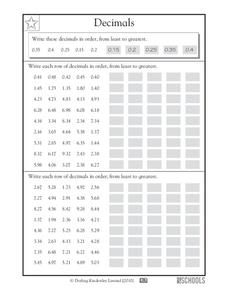Center for Innovation in Education
Unifix Cubes
Support young mathematicians with building a strong foundational number-sense using this series of printable Unifix® cube strips. Adaptable to the teaching of a variety of different concepts, from basic counting and cardinality, to...
Illustrative Mathematics
Sort and Count
Young mathematicians are on their feet and moving around in this primary grade sorting activity. After giving each child an object or picture card, they then sort themselves into groups, counting to see which has the most or least...
Illustrative Mathematics
Which Number is Greater? Which Number is Less? How do you Know?
When comparing groups of objects, it's easy for children to identify which has more, but it's not so easy for them to explain their reasoning. This simple whole-group activity provides multiple opportunities for learners to compare...
Curated OER
Rounding and Subtracting
Common Core is all about getting your learners to open their minds and think about the why and how. This problem has them thinking about unknown numbers and their relationship with one another when we round and subtract. They will have...
Baylor College
Air: The Math Link
Inflate this unit on the science of air with these math skills practice and word problems. Accompanying the children's story Mr. Slaptail's Secret, this resource covers a wide range of math topics including the four basic operations,...
THUP Games
Monkey Math School Sunshine
Hang out at the beach and listen to some relaxing tunes, all while developing basic math skills. An endless source of fun and learning for young children!
Illustrative Mathematics
Ordering 4-digit Numbers
Place value is a concept that sets a foundation for mathematical understanding. Ordering these sets of three- and four-digit numbers will help to strengthen that foundation. A great independent practice worksheet or short assessment to...
Region of Peel
Put Me in Order
Sorting fractions, integers, decimals and square roots into sequential order is an active process when you use a gym as your setting. After your class is divided into two groups and provided with number cards, they compete to see who can...
Curated OER
Multiples of 6 #2
Count by six with these helpful activities. After completing number sequences and multiplication problems from the six times table, third graders solve problems that are written out at the bottom of the page. An excellent way to work on...
DK Publishing
Write the Missing Numbers
Funny clowns and balloons help your preschoolers and kindergartners count! Each bunch of balloons is missing some numbers in its sequence. The numbers go up to 20, allowing youngsters to practice both counting and printing skills. Color...
Curated OER
Ordering Large Numbers: Numbers up to 9,200,000
Once learners understand place value, they can put all kinds of numbers in order - even eight-digit numbers! Fourth graders put groups of five numbers in order from smallest to largest. After they finish, they decipher a word problem and...
DK Publishing
Putting Numbers in Order, Numbers Up to 9,900
Put these big numbers in order! Fourth graders review the example at the top of the page before putting 16 sets of 4-digit numbers in order from smallest to largest. You can cut the three sections of problems into strips of paper for...
DK Publishing
Sliding Snails: Count by 10s
Even snails can move quickly when working through this assignment! Youngsters match written number words to their numerals (ten to 10, for example), and then decipher what numbers are covered by snail slime in a number sequnce. All of...
Curated OER
Putting Numbers in Order
Can your second graders put these 2 and 3-digit numbers in order from least to greatest? Fifteen sets of four numbers help them practice their place value, as well as their ordering skills. A great way to get them ready for more complex...
Curated OER
Putting Numbers in Order, Numbers up to 100
Party with number balloons! Young learners study four groups of illustrated balloons with numbers on them, and write the numbers in sequence from smallest to greatest, or greatest to smallest. For extra fun, have them color the balloons...
Curated OER
Ordering
Four sequences are missing some numbers; can your scholars fill them in? These aviation-themed number sequences require skip counting and counting backward. Beside each pattern learners can reference a jumbled set of numbers inside a...
Curated OER
Identifying Patterns
What's the pattern? Beginners with this skill examine four sets of objects to determine a pattern, continuing it by drawing the rest of the objects in the space provided. Next, they do the same but with two numeric patterns. These don't...
Curated OER
Ordering Sets of Measures
Using numbers with varying units (money, length, volume, distance, weight), scholars put each set in order from least to greatest. There are five numbers in each set, and they are all whole numbers with units attached (numbers in each...
Curated OER
Ordering Sets of Two
Place value is important as scholars begin ordering larger number based on their values. They order seven sets of numbers, ranging from three digits to seven digits. Then, they complete a word problem by examining four town populations...
Curated OER
Put The Numbers into Order
This presentation should provide good practice for youngsters who are just learning how to count larger numbers, and how to use a number line. In it, learners are given sets of four numbers. They use their computer mouse to click on the...
Curated OER
Patterns of 2s, 5s, and 10s
In order to connect the dots in three images youngsters skip count by twos, fives, and 10s. Encourage them to look for patterns as work, and consider giving out hundreds charts for guidance. They can also color these in once finished!
Curated OER
Finding Patterns
What's the pattern? Learners skip count to complete 12 sequences, some of which increase and some of which decrease. As they solve each number pattern they count by 2, 3, 4, 5, 6, 10, and 100, getting some extra subtraction and addition...
Curated OER
Decimals
Ordering decimals is different from ordering whole numbers, but your scholars will get the hang of it after assorting 17 sets of numbers from least to greatest. The numbers all have decimals to the hundreds place, so they use knowledge...
Curated OER
Frogs Hopping by 2s
Hop to it! Beginning counters fill in water lily number sequences as a frog "hops" across them, skip counting by twos. There are five sequences in total, and some require counting backward. Learners can reference the two examples, which...

























